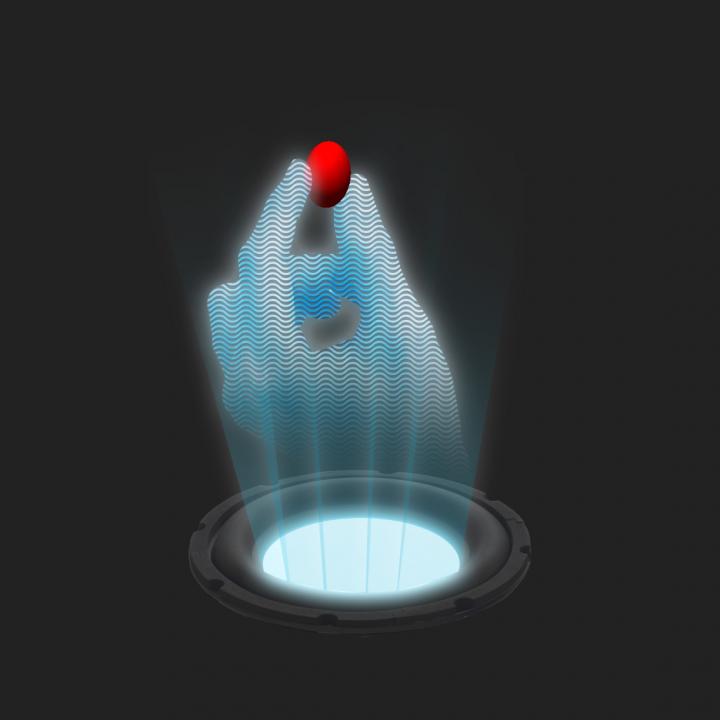From science fiction to reality — sonic tractor beam invented

The research team has created three-dimensional acoustic fields with shapes such as fingers, twisters and cages. These acoustic fields are the first acoustic holograms that can exert forces on particles to levitate and manipulate them. Image courtesy of Asier Marzo, Bruce Drinkwater and Sriram Subramanian © 2015
Tractor beams are mysterious rays that can grab and lift objects. The concept has been used by science-fiction writers, and programmes like Star Trek, but has since come to fascinate scientists and engineers. Researchers have now built a working tractor beam that uses high-amplitude sound waves to generate an acoustic hologram which can pick up and move small objects.
The technique, published in Nature Communications, could be developed for a wide range of applications, for example a sonic production line could transport delicate objects and assemble them, all without physical contact. On the other hand, a miniature version could grip and transport drug capsules or microsurgical instruments through living tissue.
Asier Marzo, PhD student and the lead author, said: “It was an incredible experience the first time we saw the object held in place by the tractor beam. All my hard work has paid off, it's brilliant.”
Bruce Drinkwater, Professor of Ultrasonics in the University of Bristol's Department of Mechanical Engineering, added: “We all know that sound waves can have a physical effect. But here we have managed to control the sound to a degree never previously achieved.”
Sriram Subramanian, Professor of Informatics at the University of Sussex and co-founder of Ultrahaptics, explained: “In our device we manipulate objects in mid-air and seemingly defy gravity. Here we individually control dozens of loudspeakers to tell us an optimal solution to generate an acoustic hologram that can manipulate multiple objects in real-time without contact.”
The researchers used an array of 64 miniature loudspeakers to create high-pitch and high-intensity sound waves. The tractor beam works by surrounding the object with high-intensity sound and this creates a force field that keeps the objects in place. By carefully controlling the output of the loudspeakers the object can be either held in place, moved or rotated.
The team have shown that three different shapes of acoustic force fields work as tractor beams. The first is an acoustic force field that resembles a pair of fingers or tweezers. The second is an acoustic vortex, the objects becoming stuck-in and then trapped at the core and the third is best described as a high-intensity cage that surrounds the objects and holds them in place from all directions.
Previous work on acoustic studies had to surround the object with loudspeakers, which limits the extent of movement and restricts many applications. Last year, the University of Dundee presented the concept of a tractor beam but no objects were held in the ray.
###
Paper: Holographic acoustic elements for manipulation of levitated objects by Asier Marzo, Sue Ann Seah, Bruce W. Drinkwater, Deepak Ranjan Sahoo, Benjamin Long and Sriram Subramanian is published in Nature Communications.
Notes to editors:
Images and a video are available for download from the following URLs:
Images:
https:/
Caption: The research team have created three-dimensional acoustic fields with shapes such as fingers, twisters and cages. These acoustic fields are the first acoustic holograms that can exert forces on particles to levitate and manipulate them.
Credit: Image courtesy of Asier Marzo, Bruce Drinkwater and Sriram Subramanian © 2015
https:/
Caption: Holograms are tridimensional light-fields that can be projected from a two-dimensional surface. The researchers have created acoustic holograms with shapes such as tweezers, twisters and cages that exert forces on particles to levitate and manipulate them.
Credit: Image courtesy of Asier Marzo, Bruce Drinkwater and Sriram Subramanian © 2015
Video:
https:/
Caption: Acoustic holograms are projected from a flat surface and contrary to traditional holograms, they exert considerable forces on the objects contained within. The acoustic holograms can be updated in real-time to translate, rotate and combine levitated particles enabling unprecedented contactless manipulators such as tractor beams.
Credit: Video courtesy of Asier Marzo, Bruce Drinkwater and Sriram Subramanian © 2015
Twitter: @LabInteract, @sonic_bruce
Sriram Subramanian was formerly Professor of Human-Computer Interaction at the University of Bristol and is now Professor of Informatics at the University of Sussex.
About Ultrahaptics
Ultrahaptics, based in Bristol, UK, is the world's leading touchless haptics company. Their unique technology brings the sense of touch to touchless interfaces, creating the magical experience of feeling without touching.
For more information visit: http://www.
Contacts:
Professor Bruce Drinkwater, Department of Mechanical Engineering, University of Bristol, tel: +44 (117) 331 5914, mobile: +44 7980 846822 or email: B.Drinkwater@bristol.ac.uk
Professor Sri Subramanian, University of Sussex, mobile: +44 7942 616920 or email: sriram@sussex.ac.uk
Heather Macdonald Tait, Ultrahaptics, tel: +44 (0)7414 811 089 or email: heather@ultrahaptics.com
Issued by the Public Relations Office, Communications & Marketing Services, University of Bristol, tel +44 (0)117 331 7276, mobile 07747 768805. Contact: Joanne Fryer. and Communications and External Affairs, University of Sussex, tel +44 (0)1273 877437. Contact: Jacqui Bealing.
Media Contact
All latest news from the category: Information Technology
Here you can find a summary of innovations in the fields of information and data processing and up-to-date developments on IT equipment and hardware.
This area covers topics such as IT services, IT architectures, IT management and telecommunications.
Newest articles

NASA: Mystery of life’s handedness deepens
The mystery of why life uses molecules with specific orientations has deepened with a NASA-funded discovery that RNA — a key molecule thought to have potentially held the instructions for…

What are the effects of historic lithium mining on water quality?
Study reveals low levels of common contaminants but high levels of other elements in waters associated with an abandoned lithium mine. Lithium ore and mining waste from a historic lithium…

Quantum-inspired design boosts efficiency of heat-to-electricity conversion
Rice engineers take unconventional route to improving thermophotovoltaic systems. Researchers at Rice University have found a new way to improve a key element of thermophotovoltaic (TPV) systems, which convert heat…



